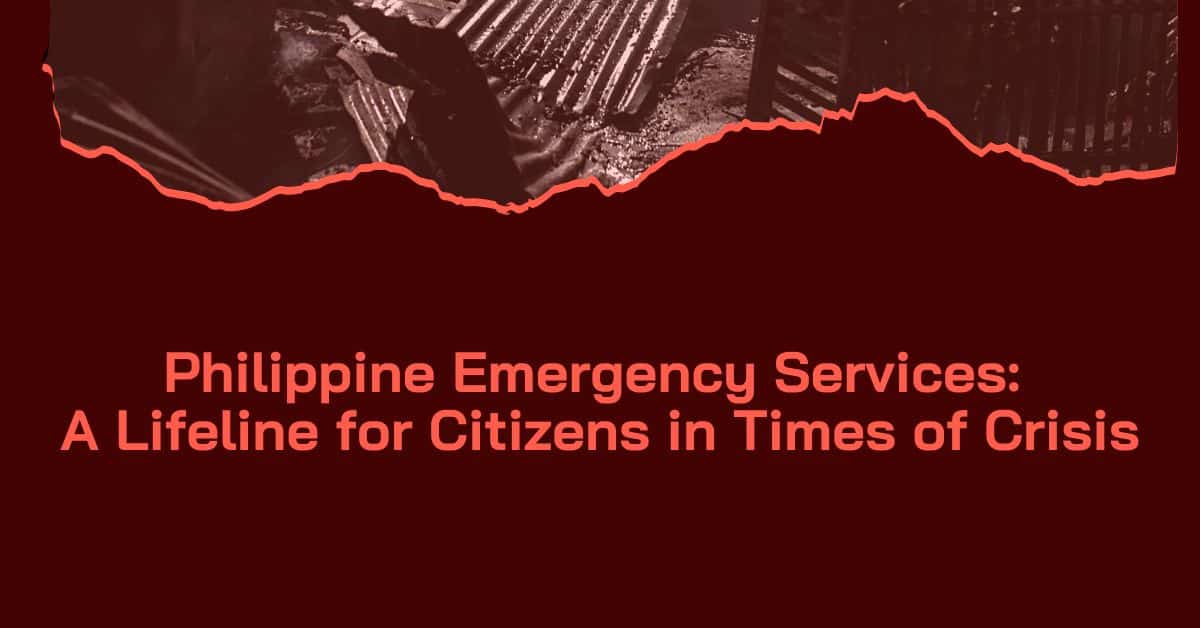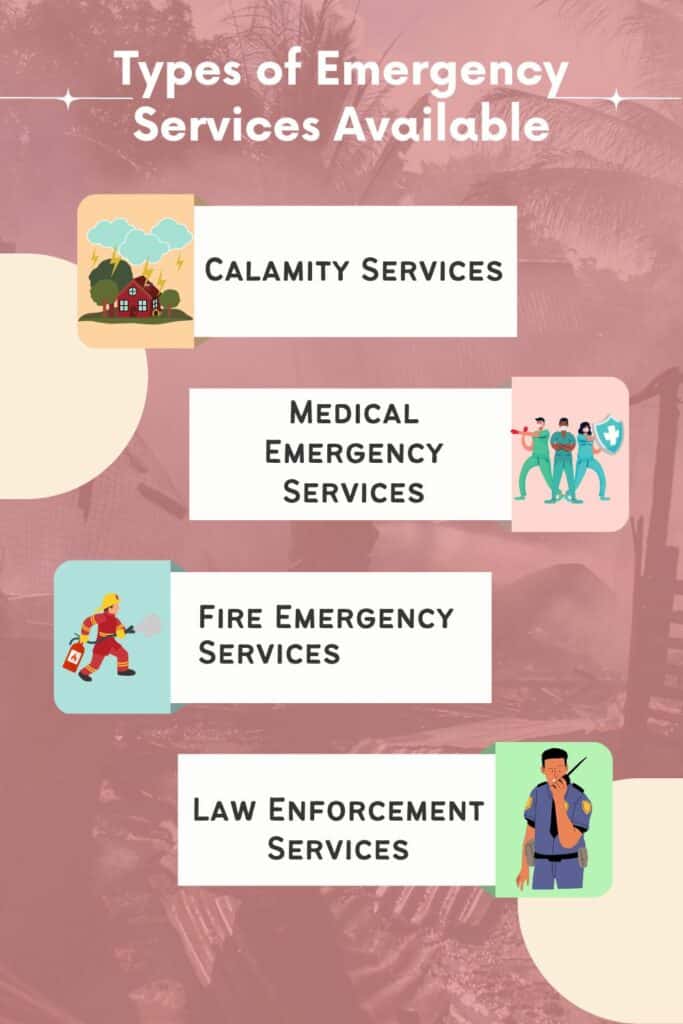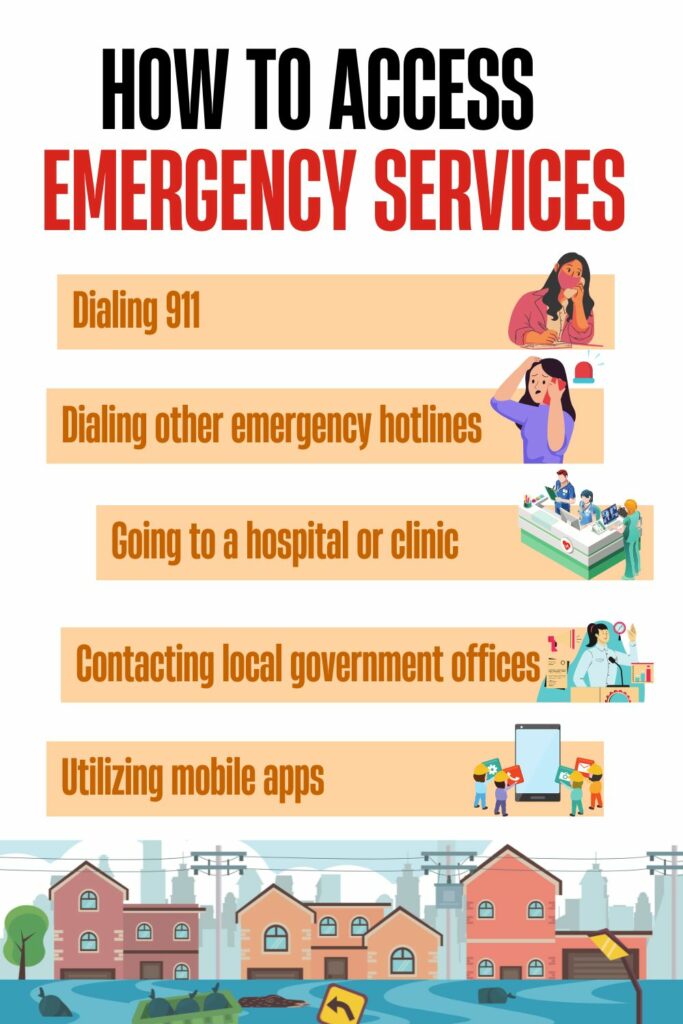The Philippines is a beautiful country, with stunning beaches, lush green forests, and vibrant culture. But it is also prone to natural disasters such as earthquakes, typhoons, floods, and landslides. In times of crisis, citizens rely on emergency services for their safety and well-being. From medical help to rescue operations and search-and-rescue teams, Philippine emergency services are a lifeline for citizens in times of crisis.
In this blog post, we will take a closer look at the different types of emergency services available in the Philippines and how they help the community during times of need. We will also discuss some important safety tips that everyone should be aware of to stay safe during disasters. So keep on reading to learn more!

Overview of Emergency Services in the Philippines
The Philippines is no stranger to natural calamities and disasters. Fortunately, the country is outfitted with a well-trained and efficient emergency services system that ranks among the best in Asia. The Philippine Red Cross (PRC) dates back to 1947 when it was established as a volunteer organization during World War II.
Today, it serves as the National Chapter of the International Federation of Red Cross and Red Crescent Societies with multiple missions, including humanitarian aid and disaster management. Aside from PRC, various government agencies such as the Department of Interior and Local Government are also actively engaged in delivering aid wherein they provide crisis counselors, search and rescue personnel, medical aid response teams, and other essential resources.
Through their collaborative efforts in tandem with international organizations like the United Nations Office for Disaster Risk Reduction (UNDRR), they have been successful at implementing comprehensive hazard preparedness protocols to keep citizens safe both locally and abroad.

Types of Emergency Services Available
Emergency services are essential for providing support during times of crisis and natural disasters. In the Philippines, there are several types of emergency services available to those who need help.
Calamity Services – When natural disasters occur, Calamity Services is ready to respond. This includes providing food and medical aid in affected areas. They also provide temporary housing for those affected by floods and other disasters.
Medical Emergency Services – Medical Emergency Services provides medical assistance in times of need. This includes ambulances, paramedics, doctors, nurses, and medical supplies. It also includes medical evacuation services that can transport people from remote or dangerous locations to safe locations where they can receive medical attention.
Fire Emergency Services – Firefighters respond to fires quickly with firefighting equipment like hoses, ladders, and fire extinguishers. They assess the situation to determine if it’s safe before entering a burning building or area and always take precautions to ensure their safety along with others before rescuing victims.
Law Enforcement Services – Law enforcement personnel protect against crime as well as help resolve conflicts between citizens peacefully when needed. They are also responsible for protecting lives during riots or protests by dispersing crowds with non-lethal force when appropriate.
These emergency services play an important role in keeping the people of the Philippines safe during times of crisis and emergencies. In addition to responding quickly, each service has its own set of protocols for handling different kinds of situations which ensure that proper care is provided whenever needed.

How to Access Emergency Services
In the Philippines, there are several ways to access emergency services:
Dialing 911: This is the main emergency hotline in the Philippines that can be used to access all types of emergency services, including medical, fire, and law enforcement. Dialing 911 is toll-free and can be done from any phone, including mobile phones.
Dialing other emergency hotlines: In addition to 911, other emergency hotlines can be used to access specific types of emergency services. For example, the Bureau of Fire Protection (BFP) can be reached by dialing (02) 729-5166, and the Philippine Coast Guard can be reached by dialing (02) 527-3877.
Going to a hospital or clinic: In case of a medical emergency, it is best to go to the nearest hospital or clinic as they are equipped to handle medical emergencies. Below is a list of hospitals and responders providing emergency services in the Philippines, divided by region:
Luzon
- Philippine General Hospital
- East Avenue Medical Center
- Jose Fabella Memorial Hospital
- National Center for Mental Health
- Research Institute for Tropical Medicine
- San Lazaro Hospital
- Quezon City General Hospital
Visayas
- Corazon Locsin Montelibano Memorial Regional Hospital
- Cebu City Medical Center
- Vicente Sotto Memorial Medical Center
- Western Visayas Medical Center
Mindanao
- Southern Philippines Medical Center
- Cotabato Regional and Medical Center
- Davao Regional Hospital
- Zamboanga City Medical Center
Contacting local government offices: In case of a disaster or other emergency, it is best to contact the local government office for assistance. Below is a list of local government offices providing emergency services in the Philippines, divided by region:
Luzon
- Philippine Red Cross – Luzon Office
- National Disaster Risk Reduction and Management Council – Luzon Office
- Department of Social Welfare and Development (DSWD) Region I, II, III, IVA, IVB
- Department of Health (DOH) Region I, II, III, IVA, IVB
- Bureau of Fire Protection Region I, II, III
Visayas
- National Disaster Risk Reduction and Management Council – Visayas Office
- Department of Social Welfare and Development (DSWD) Region VII & VIII
- Department of Health (DOH) Regions VI & VII
- Bureau of Fire Protection Region VI & VII
Mindanao
- National Disaster Risk Reduction and Management Council – Mindanao Office
- Department of Social Welfare and Development (DSWD) Regions IX & X
- Department of Health (DOH) Regions IX & X
- Bureau of Fire Protection Regions IX & X
Utilizing mobile apps: There are also mobile apps available that allow citizens to quickly and easily access emergency services. These apps usually include features such as emergency contacts, location tracking, and emergency alerts.
It is important to note that for emergency services to respond effectively, it’s crucial to provide accurate information such as the location, and nature of the emergency when calling for help. Below is a list of mobile apps available for use in the Philippines to access emergency services:
- Philippine Disaster Resilience Foundation (PDRF)
- Kaya Natin PH
- MDRRMO
- Pantawid Pasada
- Bayanihan App
- HandsOn Manila App

Government Efforts to Improve Emergency Services
The Philippine government has taken several steps to ensure that emergency services are accessible and up to par with international standards. Below are some of the efforts they have undertaken:
Increased Funding – The government has allocated significant amounts of funding toward providing better infrastructure and equipment for emergency services. This includes new ambulances, medical supplies, firefighting equipment, training facilities, and other needs.
Enhanced Training – Another step the government has taken is to enhance the training programs for personnel involved in emergency response teams. This includes regular drills and simulations that help sharpen their skills as well as educate them on the latest safety protocols and techniques.
Development of Technology – To further improve their services, the government has invested in developing new technologies such as drones that can be used for surveying dangerous areas or delivering medical supplies quickly.
By making these improvements, the Philippine government is striving to ensure high-quality emergency services throughout the country. This will not only provide quick assistance during times of crisis but also ensure a safe environment for all citizens at all times.

In conclusion
Emergency services in the Philippines are essential for providing aid and support during times of crisis. From medical help to search-and-rescue teams, this dedicated personnel does their utmost to keep citizens safe and secure. The government has also taken steps to improve emergency services by increasing funding, enhancing training programs, and developing new technologies.
By doing so, they are helping to ensure that citizens of the Philippines have access to quick and efficient assistance in times of need. With their help, we can all remain safe during disasters and natural calamities.








